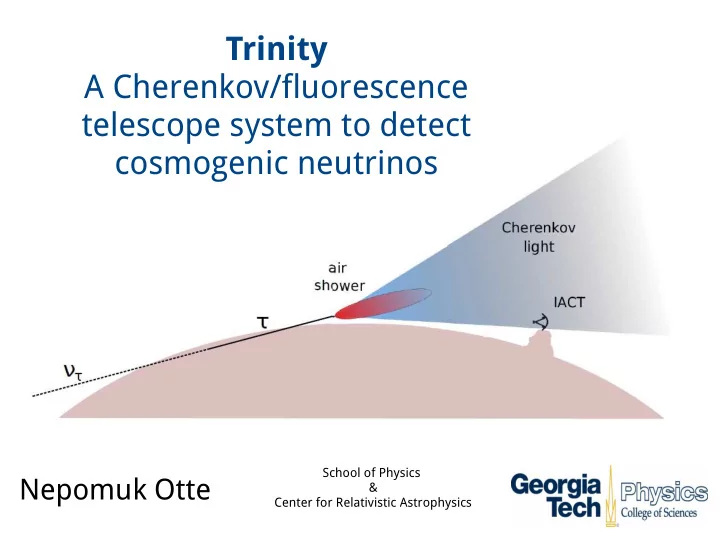

Trinity A Cherenkov/fluorescence telescope system to detect cosmogenic neutrinos School of Physics Nepomuk Otte & Center for Relativistic Astrophysics
Target sensitivity 10 -9 GeV/s/cm 2 /sr Science Motivation: ● What is the composition of NTA 3yrs UHECR? ● Extension of IceCube detected ν flux to 10 9 GeV? ● Test of fundamental physics
Image in Imaging camera Atmospheric Cherenkov Technique Proven Technique Angular resolution <0.1° – Energy resolution 10% – – Excellent background suppression 3 Observations of SNRs with VERITAS
Nepomuk Otte 4
Trinity Cherenkov/fluorescence telescope system 1-2 km above ground 360 degrees azimuthal acceptance 1 m 2 effective mirror area Sensitivity determined by: Shower physics Neutrino/tau physics (vertical acceptance) Light emission pattern (azimuthal acceptance) Instrument (event reconstruction) Image intensity (energy threshold) Image resolution (angular resolution / background suppression) Nepomuk Otte 5
Probability for τ Emergence ν energy Target material: Rock with ρ = 2.65 g/cm 3 Works best for: ● >10 8 GeV ● ~50 km target Limiting factors: ● Target to thin: ν does not convert ● Target to thick: τ does not make it out -4° elevation -0.05° -0.1° -0.3° -1° Probability for ν conversion and emergence of τ from ground
Azimuthal Acceptance Lots of Cherenkov light scattered outside of primary 1° cone 10° Nepomuk Otte 7
Atmospheric Absorption
Radial Cherenkov Intensity Distribution
The Top View: Fluorescence Azimuth acceptance: ~360° Yield: 30 photons / MeV Keilhauer et al. 2012 For 10 9 GeV τ: ~200 photons per m 2 in telescope if shower is 80 km away 80 km Nepomuk Otte 10
Detection threshold 1 neutrino In 3 years 25% duty cycle Uncertain by a factor of two
Detector Design Requirements 360° azimuthal FoV and 5° vertical FoV 1m 2 effective mirror area Minimum 0.3° angular resolution → >10 pixel per image Signal sampling speed 100 MS/s Single photoelectron resolution
Machete A transit imaging atmospheric Cherenkov telescope to survey half of the very high energy γ-ray sky J. Cortina, R. López-Coto, A. Moralejo Astropart.Phys. 72 (2016) 46-54 Scaled down to 1m 2 mirror: ● D=1.2 m, f=1.2 m, f/D=1 ● Mirror surface : 1.2m x 2.5 m ● 90% containment : 0.42° ● plate scale factor : 20.9 mm/deg ● Camera size : 104.5 x 1254 mm 2 = 0.13 m 2 ● Pixel size : 6 x 6 mm 2 , 0.3° diameter → 3622 pixel ● Light concentrator : factor 4 → sensor size 3x3mm 2 (SiPMs) FOV of 5 × 60 sq deg Costs per station (optics only): ~$50,000
Data Acquisition Requirements Kieda (1995) Photon arrival times spread out to ~10 µs → “slow” 100MS/s DAQ sufficient NSB: 36mm 2 pixel record about → 4 photon / 1 μs Single pe signal stretched to 100 ns Nepomuk Otte 14
Signal Chain amplifier + shaper photodetector 100 MS/s, 8 bit FADC SiPMs as photodetectors 3x3 mm 2 sensor + light concentrator Continuous sampling with 100 MS/s Signal processing and trigger in FPGA Allows flexible trigger schemes using time and amplitude information Cost per channel ~$100 Nepomuk Otte 15
Back on the Envelope Cost Estimate 6 Detector stations for 360° FoV: 22,000 pixel * $100/channel (sensor + readout) = $2.2M Optics ~$400k Infrastructure ~$400k $3M total + R&D costs ~$500k Nepomuk Otte 16
Next Steps Nepomuk Otte 17
Conclusions A dedicated Cherenkov/fluorescence instrument can deliver a sensitivity comparable to ARA/ARIANA Costs fit into a $5M MRI Technique is proven and well established in VHE gamma rays Very good angular resolution and energy reconstruction Open issues need to be addressed with a small prototype Background photon rates Cosmic Ray background Signal extraction and triggering Advanced methods can significantly improve sensitivity and lower energy threshold Data analysis: How well can up-going showers separated from down-going ones
Backup Nepomuk Otte 19
Air Shower Simulations With CORSIKA 7.56 modified to do Cherenkov emission for upward going particles (credit to D. Heck) Curved atmosphere with changing index of refraction VERITAS atmospheric attenuation models generated with modtran Restrict simulations to gammas first interaction always the same (100m above ground) pure em-shower no hadronic component, which widens Cherenkov footprint No LPM effect (important above 10 7 GeV), which makes shower longer
Simulated Detector Configuration detector plane 1 km Cherenkov photon tracks 100m Tau trajectory side view
The Side View Most extreme situation with: ● 5° angle emerging from ground Cherenkov cone ● τ decaying and developing shower within 50 km Showers start to be fully contained in camera if it is >60 km from telescope ~10° ~ 50 km 1 km τ decay above ground ~5° FoV in vertical <10 km >60 km α<5° Nepomuk Otte 22
Cherenkov Spectrum
Comparison Cherenkov and Fluorescence Cherenkov Fluorescence Azimuthal ~20° ~360° acceptance Elevation ~5° ~5° acceptance Area on 120,000m 2 20,000m 2 ground ~3 time sensitivity of Cherenkov Nepomuk Otte 24
Prototype Site IOTA site on Kitt Peak, AZ
Recommend
More recommend